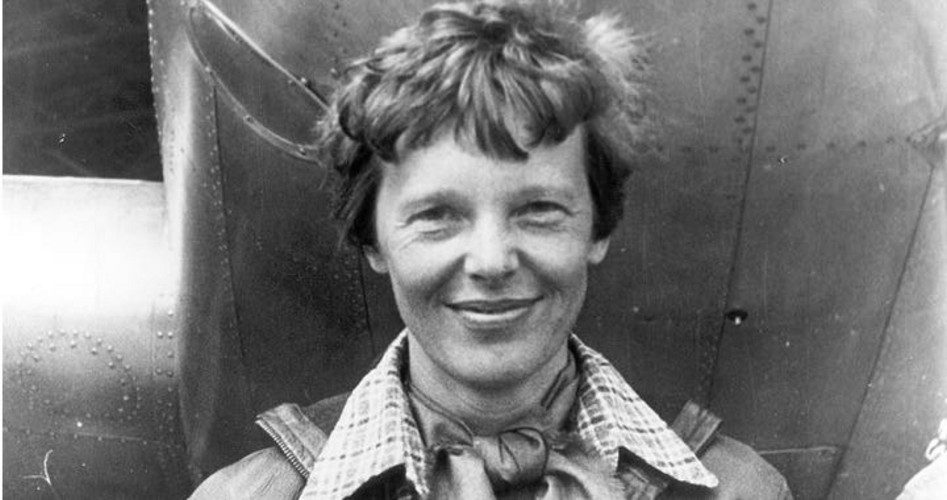
In concurrence with the 80th anniversary of the disappearance of America’s first woman pilot to fly across the Atlantic comes the History Channel’s investigative documentary Amelia Earhart: The Lost Evidence.
On July 2, 1937, Amelia Earhart and her navigator, Fred Noonan, disappeared over the Pacific Ocean, creating a mystery that would baffle the world for years to come. Now, former Executive FBI Director Shawn Henry claims to have solved the 80-year-old mystery, calling it “the biggest government cover up of all time.”
The documentary suggests that, contrary to popular belief, Earhart did not crash into the Pacific, but actually landed in the Marshall Islands, was captured by the Japanese, and died on the island of Saipan as a prisoner.
A previously unknown photograph from the National Archives has been rediscovered and is the key piece of evidence in the enigma, according to Henry. The picture, bearing the official stamp of the Office of Naval Intelligence (ONI), reads “Marshall Islands, Jaluit Atoll, Jaluit Island, Jaluit Harbor.” In the photo are several people on a dock, and a ship in the background, identified as the military craft Koshu Maru, with a barge in tow. On the barge is an airplane, measuring the same length as Earhart’s plane, and on the dock are two people bearing unmistakable resemblances to Earhart and Noonan. [Udate: This photo was apparently prior to 1937 and therefore could not have shown Earhart and Noonan; see the addendum at the end of the article.]
Upon examination, digital forensic analyst Doug Carner determined that the photograph was indeed genuine with no alterations. Also studying the photo was Kent Gibson, a forensic analyst specializing in facial recognition. He confirmed the probability that the two images in question were “very likely” to be Earhart and Noonan. This information would place the two aviators in Japanese territory, and bring them in contact with the the vessel that is reported to have taken the survivors away after the landing.
During the broadcast, Shawn Henry and decorated pilot Colonel Dan Hampton traveled to the islands to examine the sites in question and visit with eyewitnesses or their relatives in regard to the capture of Earhart and her navigator. In a 1983 interview, medic Bilimon Amaron recounted his story of treating “two Americans” on a ship in Jaluit, describing the man’s injuries. An important factor that gives credibility to Amaron’s account is the fact that Americans were excessively scarce, if at all, in the Marshall Islands. His description of the injuries of the man were identical to the wounds Noonan supposedly suffered after a reported crash.
It seems that Earhart attempted to call for help after a crash, and Nina Paxton, an RN from Ashland, Kentucky, wrote several letters to the office of Naval Intelligence after hearing on her shortwave radio that Earhart was near Mili Atoll, that Noonan was injured, and that they couldn’t stay long. The special added that records indicate that radio transmissions from Earhart using Morse Code continued for three full days after the disappearance, directing assistance to the Marshall Islands.
Another disturbing piece of evidence brought to light by Henry indicates not only a coverup, but manipulation by the U.S. government. On July 30, 1937, the same day that the U.S. Navy publicly declared Amelia Earhart and Fred Noonan to be lost at sea, the State Department sent a letter to the U.S. ambassador in England stating:
Evidence, which to many sources seems positive, indicates that Amelia Earhart (Mrs. Putnam) was on land the two nights following her disappearance.
The investigation revealed a letter from the National Archives that had been discovered, supporting even more evidence of neglect. The letter reported claims of a file consisting of 170 pages, which included a report dated January 7, 1939. That report had information that Earhart was being held prisoner in the Marshall Islands.
One other account highlighted came from Genevieve Cabrera, a local historian in Saipan, whose great-aunt, Joaquina Cabrera, had been assigned to do the laundry for the prisoners at Garapan prison. She recalled seeing a white female whom she thought looked like a man. Again, Americans would have attracted much attention on the sheltered island. So a white woman would have been rare enough, but a white woman dressed like a man, as it would have seemed, would have definitely been an anomaly.
The nearly two-hour docudrama gave a vivid depiction of “a world-famous aviator who got caught up in an international dispute, was abandoned by her own government, and made the ultimate sacrifice,” according to Shawn Henry. He concluded that Earhart “may very well [have been] the first casualty of World War II.”
If this feature is correct, then there are many more questions concerning this monumental mystery, though we may never find the answers. However, more than a puzzle to be solved, the uncertain ending of this legend is a tragedy to be lamented. As Henry passionately, and appropriately, asserted, “People seem to think of Amelia Earhart as just a piece of history, like an artifact. But she was a human being.”
Addendum (July 12, 2017): Since the publication of this article, The New American has been made aware that the photograph the History Channel documentary touted as the key piece of evidence linking Amelia Earhart and Fred Noonan to the Marshall Islands in 1937 appears to have been published in a Japanese-language travelogue two years previously, in 1935.



